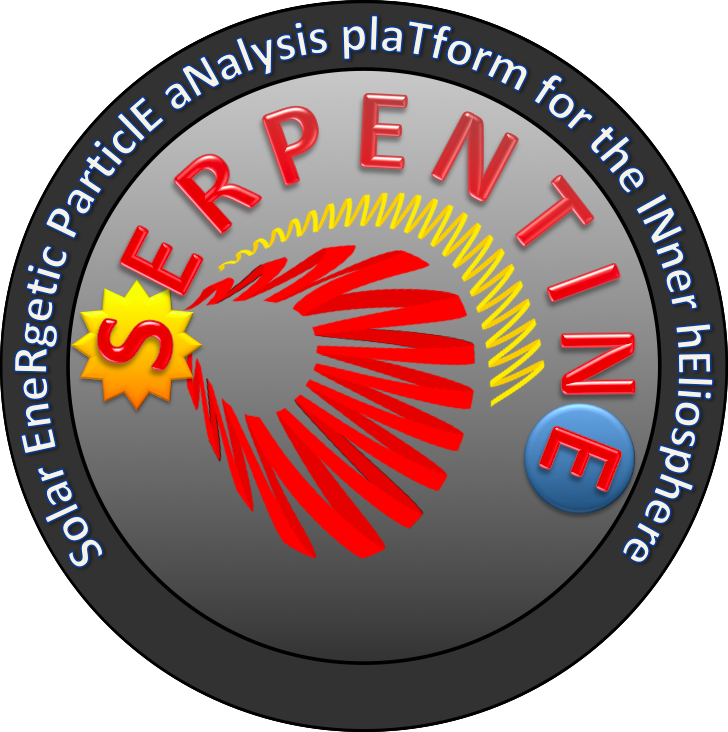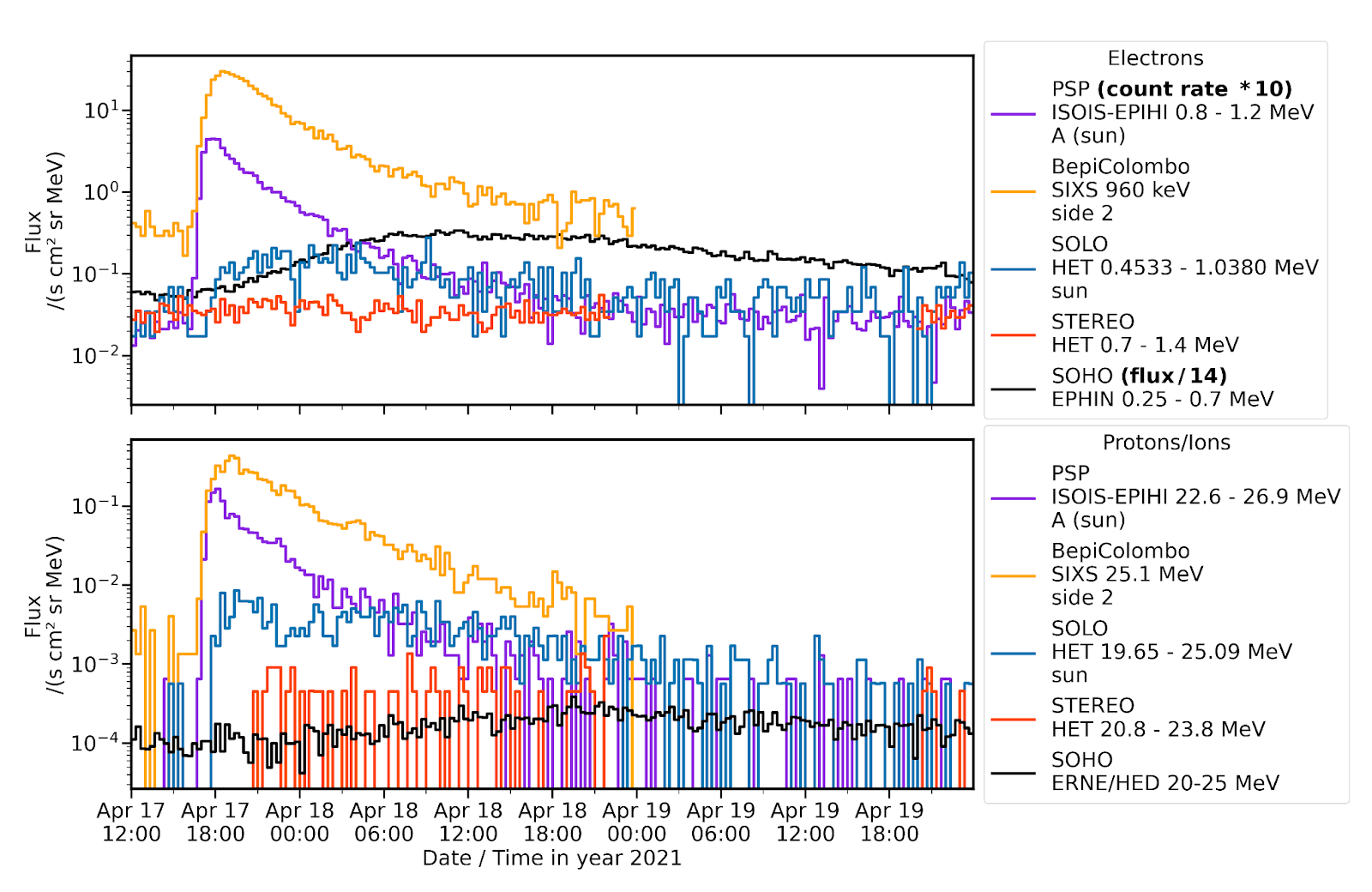An exhaustive multi-spacecraft analysis of the 17 April 2021 event revealed that multiple distinct SEP injections at the Sun played a major role in creating the wide longitudinal spread of solar energetic particles (SEPs) in the inner heliosphere. This points toward a new possible mechanism for the generation of widespread SEP events.
SEPs propagate in the interplanetary medium primarily along the magnetic field lines, which form a spiral pattern close to the ecliptic plane. However, a small fraction of SEP events can be observed over very wide longitudinal ranges in the inner heliosphere, sometimes even reaching spreads of 360° around the Sun. The reason for such extraordinarily wide particle particle distributions is still debated. On the one hand strong particle diffusion perpendicular to the spiral magnetic field lines was proposed to explain such events. On the other hand an extended source region like a shock driven by a coronal mass ejection (CME) could provide an alternative.
On 17 April 2021 the newly expanded spacecraft fleet observed the second of such widespread events of solar cycle 25. It is even the first event, in which energetic electrons and protons were detected by five well-separated spacecraft in the inner heliosphere, that is BepiColombo, Parker Solar Probe, Solar Orbiter, STEREO A, and near Earth spacecraft such as SOHO and Wind.
Figure 1 (right) shows the spacecraft constellation on 17 April 2021. The black arrow marks the longitude of the associated flare. Figure 1 (left) shows the multi-spacecraft observations of energetic electrons (top) and protons (bottom) with highest SEP intensities observed by BepiColombo as expected from its best magnetic connection to the flare location. However, even near Earth, at a longitudinal separation of 144° from the flare location, a gradual, still energetic, SEP event was detected.
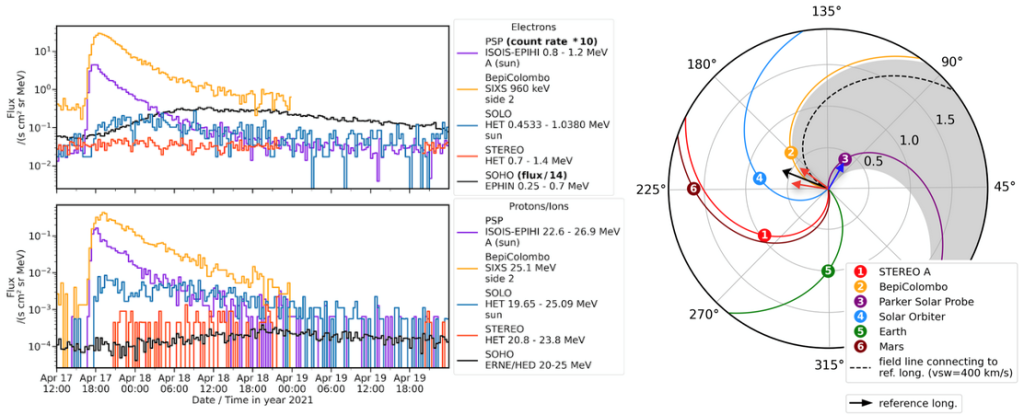
The SERPENTINE team analyzed this event in great detail in collaboration with various members of the scientific community to identify the reason for the wide SEP spread of this event. Remote-sensing observations of the solar corona revealed a rather slow (~880 km/s) and narrow (46°) CME as determined from reconstruction based on multi-point coronagraph observations as shown in Fig. 2.
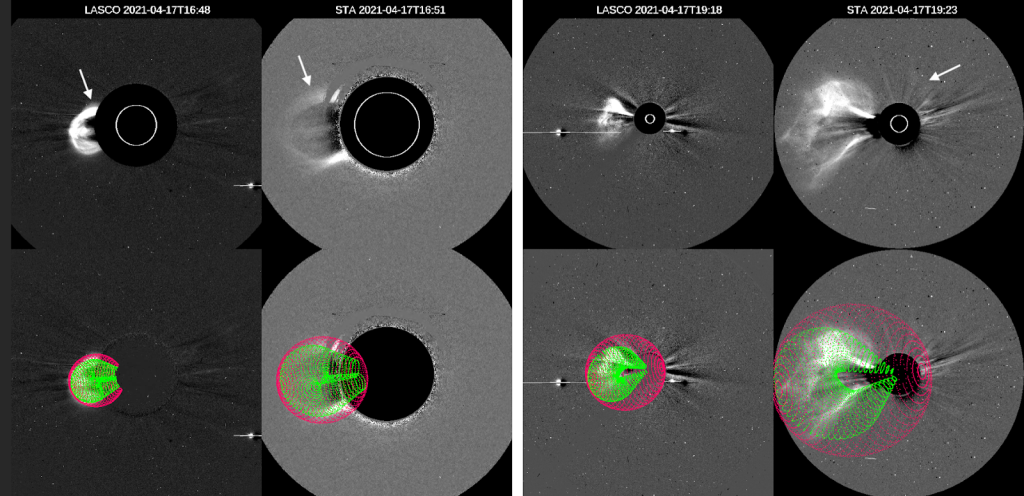
Hard X-ray (HXR) observations by Solar Orbiter / STIX revealed an unusually long-lasting flare with a duration of about an hour (see the green time series in Fig. 3). Also the solar radio burst activity was long-lasting (~40 min) showing at least four distinct injection episodes (see radio spectrogram in the bottom of Fig. 3).
The team further analyzed the magnetic connection of each spacecraft with the solar corona using potential field source surface extrapolations. Together with the coronal shock reconstruction (red mash in Fig. 2) this allowed us to determine when the shock established a magnetic connection with each spacecraft (illustrated by the vertical shaded ranges in Fig. 3). Based on SEP onset times as observed at the various spacecraft we then determined their corresponding inferred solar injection times. In order to identify the corresponding solar sources of these particles we then compared these with the times of the HRX peaks of the flare, the various radio burst episodes, and the shock connection times, which is illustrated in Fig. 3. This comparison revealed that:
- The solar injection times of energetic electrons are significantly earlier than those of protons as observed by Parker Solar Probe and STEREO A
- SEPs observed by different spacecraft were likely associated with different injection episodes as marked by the different HXR peaks or radio burst episodes
- The estimated shock connection times were too late to explain the SEP onsets at most spacecraft except for BepiColombo and Solar Orbiter
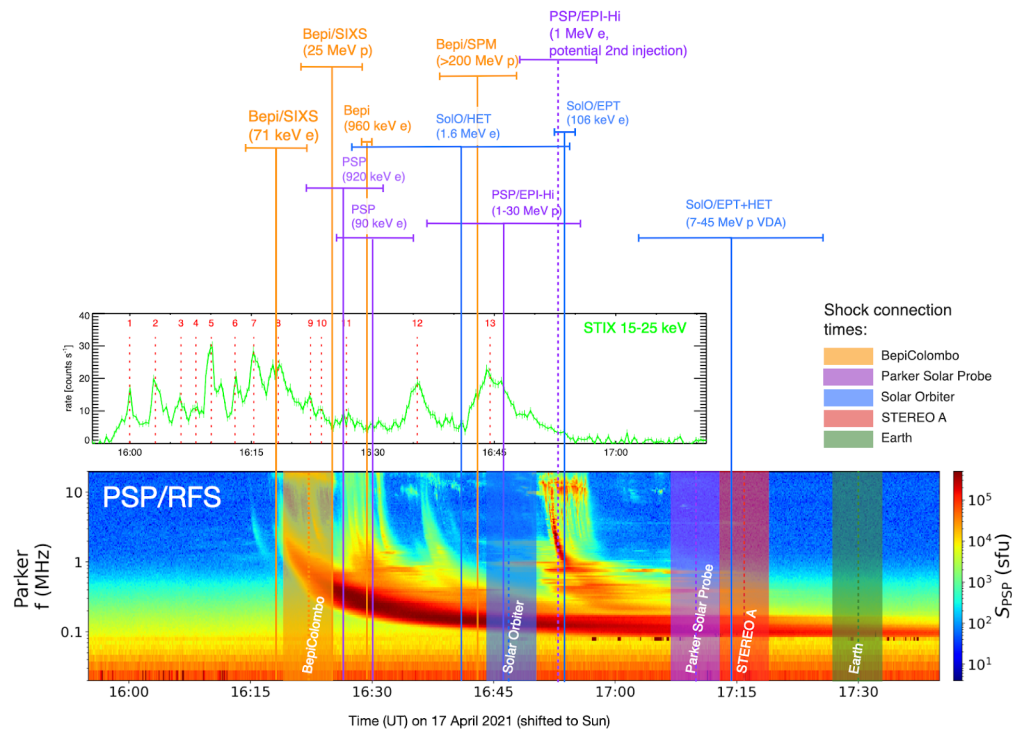
The directions of distinct SEP injections
Two of the four main radio type III burst episodes (the first and third one) allowed for a determination of the radio burst propagation direction and this revealed directions that significantly differ from the flare longitude. These directions are marked by red arrows in Fig. 1. The other two type III burst episodes (the second and forth one) showed very strong polarization as observed by Parker Solar Probe, which suggested that these were directed toward the spacecraft (marked by the blue arrow in Fig. 1).
In total these four distinct SEP injections cover a longitudinal range of 110° (marked by the gray shaded area in Fig. 1), which could be the main contributor to the wide SEP spread in this event.
Different sources of energetic electrons and protons?
Additionally to the different inferred injection times of electrons and protons we found that for BepiColombo, Parker Solar Probe and Solar Orbiter protons showed stronger and longer-lasting anisotropies compared to electrons. This suggests an ongoing proton injection process, which could be explained by the shock, while electron observations could be explained by a shorter injection process like a flare.
Observations at STEREO A and Earth show only little or no SEP anisotropies suggesting that perpendicular diffusions was involved in bringing the SEPs to these observers.
We conclude that the wide SEP spread of the 17 April 2021 event was caused by a combination of different processes, namely perpendicular diffusion and several distinct SEP injections into different directions. The electron event as well as the early proton event was likely flare-dominated while the long-lasting proton anisotropies might be caused by ongoing acceleration at the CME-driven shock.
Find the full article here: DOI: https://doi.org/10.1051/0004-6361/202345938
